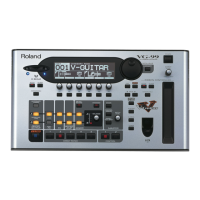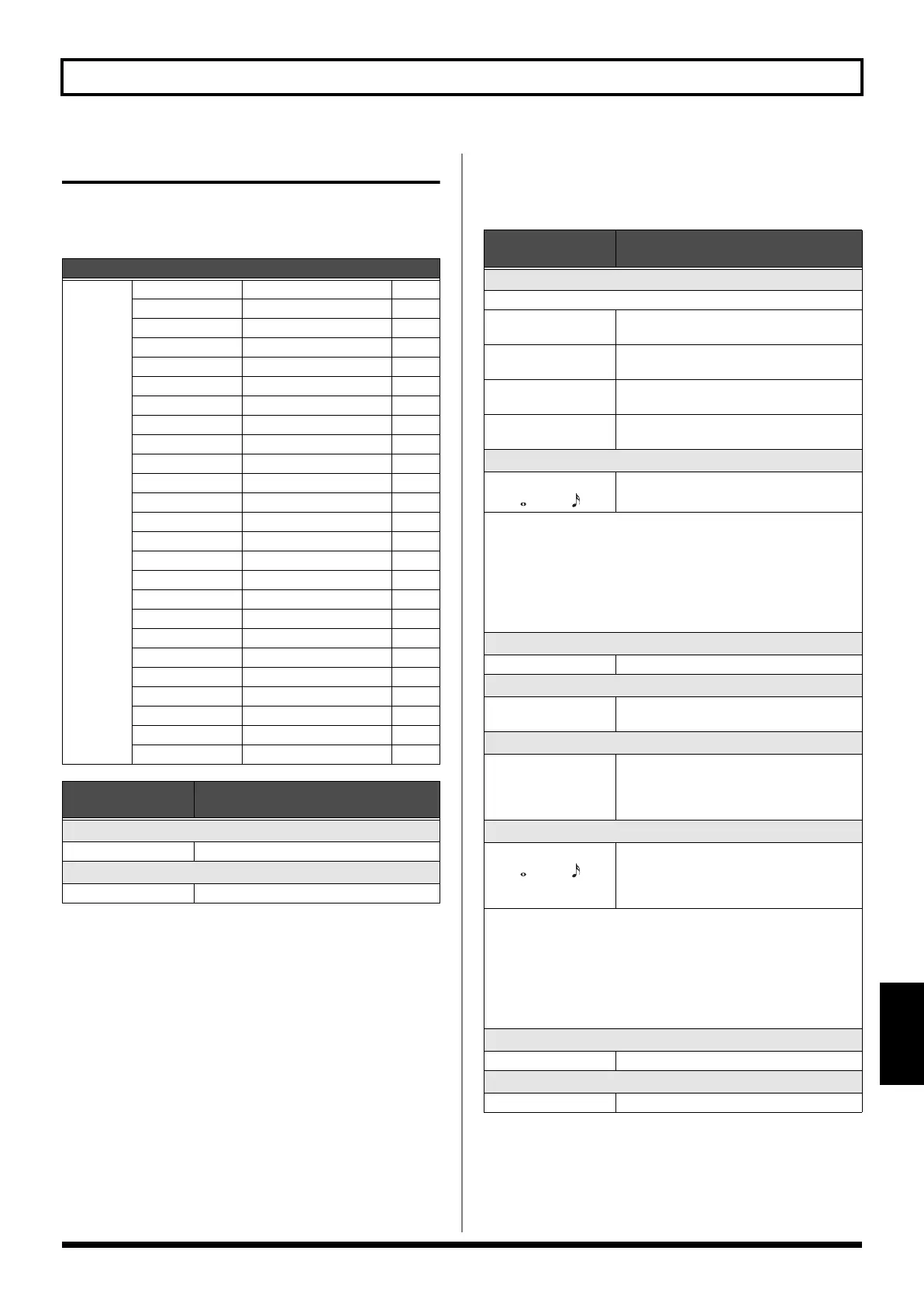Why are the patches not switching on my Roland VG-99 Music Pedal?
- KkennethbergAug 18, 2025
If your Roland Music Pedal patches aren't switching, ensure that the Play screen is displayed. Press [EXIT] one or more times to return to the Play screen.

 Loading...
Loading...
Why are the patches not switching on my Roland VG-99 Music Pedal?
If your Roland Music Pedal patches aren't switching, ensure that the Play screen is displayed. Press [EXIT] one or more times to return to the Play screen.
Why is there no sound coming from my Roland VG-99 Music Pedal, or why is the volume low?
If you're experiencing no sound or low volume with your Roland Music Pedal, try replacing the connecting cable to rule out a short. Also, if a Divided pickup is connected, set [SYSTEM] - GK - GK CONNCT to ON (if AUTO does not function well). If a Divided pickup is not connected: set [SYSTEM] - GK - GK CONNCT to OFF. Ensure that the [COSM GUITAR] is switched on and that [A/B BALANCE] is set correctly for the channel in use. Also, remember to check the settings for the connected device and adjust the knob to an appropriate setting.
| Brand | Roland |
|---|---|
| Model | VG-99 |
| Category | Music Pedal |
| Language | English |
Read and observe important instructions for the prevention of fire, electric shock, or injury.
Instructions regarding the proper and safe use of the unit's power supply and AC adaptor.
Description of D-Beam, ribbon controller, FC-300, MIDI, and V-LINK functions.
Instructions for installing the GK-3 pickup and configuring GK settings.
Instructions for using the VG-99's built-in tuner for accurate guitar tuning.
Detailed steps for setting up the VG-99 based on the installed divided pickup.
Introduction to COSM Guitars, Poly Effects, COSM Amps, Effects, and Mixer.
Configuring output signals and levels for various jacks and connectors.
Steps for selecting and adjusting COSM GUITAR modeling types.
Steps for selecting and customizing COSM AMP types and parameters.
Explanation of Alternate Tuning, including TUNING, BEND, and AB LINK settings.
Instructions for configuring POLY FX and standard FX effect parameters.
Controlling the mix between channels based on picking dynamics.
Configuring delay and reverb parameters for the mixer section.
Modifying the overall tone using the Total EQ parameters.
Procedure for saving edited patch settings to memory.
Detailed steps for customizing the preamp section of COSM AMP.
Steps for customizing the speaker simulation parameters.
Detailed steps for customizing overdrive and distortion effects.
Instructions for customizing the wah effect parameters.
Inputting and selecting GK settings for optimal divided pickup performance.
Using the four-band global equalizer to adjust overall tone.
Adjusting the global reverb level for performance venue acoustics.
Assigning functions to GK Volume, S1, and S2 switches.
Setting the global threshold for the noise suppressor effect.
Using Global settings to adjust overall tone without altering individual patches.
Assigning functions to GK controls, switches, and external pedals.
Choosing the correct GK pickup type (GK-3, GK-2A, PIEZO).
Fine-tuning input sensitivity for each string of the divided pickup.
Determining if controller values persist when patches are switched.
Configuring system-wide output signals and levels for all jacks.
Configuration for controlling the FC-300 via the VG-99.
Setting Program Change messages to transmit with individual patches.
Synchronizing VG-99 timing to MIDI Clock from external devices.
Selecting MONO or POLY mode for MIDI message transmission.
Controlling the VG-99 using MIDI for patch changes and parameter adjustments.
Configuration of VG-99's MIDI-related functions.
Using Exclusive messages for data transfer (bulk dump/load).
Converting guitar performance data to MIDI for use with synthesizers.
Adjusting patch-specific parameters for the GUITAR TO MIDI function.
Assigning Control Change messages to panel knobs, pedals, and switches.
Using external MIDI devices to control VG-99 functions like patch switching.
Configuring the Direct Monitor function for headphone or line outputs.
Prerequisites for USB functionality: installing the VG-99 USB driver.
Setting the digital audio signal routing for USB input and output.
Setting the audio input port to record VG-99 output directly to a computer.
Applying VG-99 effects to audio played from a computer.
Procedure for switching between STANDARD and ADVANCED driver modes.
Using D Beam and Ribbon controllers for real-time sound manipulation.
Assigning parameters to F1-F6 knobs for real-time control.
Mapping functions to GK controls, pedals, and MIDI devices.
Assigning and recalling favorite patches using DIRECT PATCH buttons.
Using finger movement on the ribbon controller to change sounds.
Using D Beam or Ribbon Controller's PITCH function to simulate a tremolo arm.
Procedures for copying and exchanging patches between different locations.
Methods for saving tone settings to patches or Favorite Settings.
Using internal pedal functions (Internal Pedal, Wave Pedal) for parameter control.
Using guitar performance to control video playback via V-LINK.
Using hand motion or guitar neck over D Beam to change sounds.
Using the FREEZE effect to hold sounds indefinitely.
Saving preferred effect processor settings as Favorite Settings.
Procedure for restoring the VG-99 to its original factory condition.
Detailed descriptions of COSM GUITAR parameters.
Introduction to COSM AMP characteristics, speaker sizes, and cabinet shapes.
Parameters for various acoustic guitar COSM models.
Detailed explanation of Alternate Tuning functions: TUNING, BEND, 12-STRING, DETUNE, HARMONY.
Parameters for the Pedal Bend effect, controlling pitch and pedal position.
Parameters for the Limiter effect, controlling attack, threshold, and ratio.
Parameters for various electric guitar COSM models.
Parameters for various synthesizer COSM models (GR-300, etc.).
Parameters for the Poly Compressor effect, including sustain and attack.
Detailed parameters for the Compressor effect (COMP).
Parameters for the Wah effect, including type, Q, range, and presence.
Adjusting tone using the parametric EQ for low-middle and high-middle ranges.
Parameters for the Chorus effect, including rate, depth, and modes.
Parameters for the Pitch Shift effect, including voice, mode, and pitch.
Parameters for the Foot Volume effect, controlling level and volume curve.
Detailed parameters for JC CLEAN, TW CLEAN, CRUNCH, COMBO, BG LEAD, and other amps.
Detailed parameters for custom amp settings, including gain and EQ.
Parameters for the Bass Amp Vintage simulation.
Parameters for the Bass Amp Modern simulation.
Parameters for the Poly Distortion effect, including mode and drive.
Parameters for Overdrive/Distortion effects (OD/DS).
Parameters for the Delay effect, including type, time, and feedback.
Parameters for the Reverb effect, including type, time, and density.
Parameters for the Phaser effect, controlling type, rate, depth, and resonance.
Parameters for the Harmonist effect, including key, voice, and harmony.
Parameters for the Noise Suppressor effect, controlling threshold and release.
Instructions for using the Hold Delay function for recording and layering sounds.
Parameters for the Feedbacker effect, enabling feedback playing techniques.
Parameters for the Advanced Compressor effect, controlling sustain and attack.
Mixing signals for Channel A and Channel B, including MIX SW and PAN.
Adjusting the overall tone using the Global EQ for Main and Sub outputs.
Setting the sequence of Program Change messages output upon patch changes.
Selecting fixed or free correspondence between received program numbers and patches.
Adjusting the mixed signal tone with a four-band parametric EQ.
Determining which signals are output at each output jack and their levels.
Using picking dynamics to control channel mix and balance.
Assigning functions to controllers like GK, pedals, and MIDI devices.
Setting up GK connection type, functions, and mode.
Applying delay and reverb effects jointly to Channel A and Channel B.
Introduction to the GUITAR TO MIDI function for converting guitar data to MIDI.
Restoring the VG-99 to its original factory condition.
Technical specifications for the VG-99 V-Guitar System.
Addressing additional troubleshooting scenarios for stereo effects and parameter control.
Resolving issues with saving settings, patch switching, MIDI communication, and controller assignment.
System requirements for using the VG-99 Editor and Librarian software.
List of potential error messages and instructions for resolution.
Common problems and solutions for VG-99 operation.
Steps to resolve problems related to no sound or low volume.